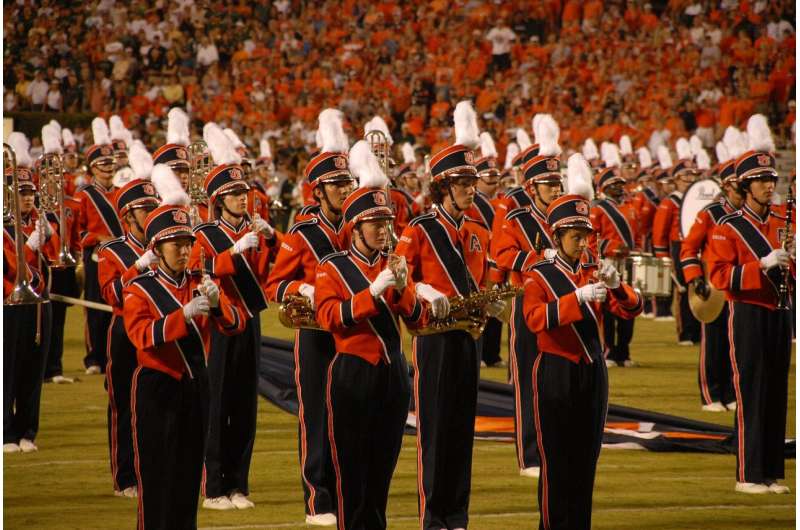
Nearly every fall, as football teams return to the field, tragic stories of players falling ill and even dying of heat trauma make the headlines. What many don’t consider is that marching band members—who don heavy uniforms and perform in the same sweltering temperatures—may also be at risk.
A study led by the University of Kansas has measured core temperatures, hydration and sweat levels of marching band members and found that they are very much at risk and deserve access to athletic trainers for their safety—just as players do.
The study used high tech methods to gauge band members’ body core temperatures during practices and performances. The results show that, while the performers often do their best to stay hydrated, the risks are such that policies should be enacted to respond when they suffer heat illnesses. The results also show that bands and institutions should start conversations on how to provide access to trainers and prevent heat illness from becoming tragic.
“Just how hot they got while playing was a bit surprising,” said Dawn Emerson, assistant professor in physical therapy and rehabilitation science at the KU Medical Center and the study’s lead author. “We’re used to working with football, track, soccer and the traditional fall sports for heat illnesses. Anecdotally, we were aware that band members could overheat, but there were really no studies to confirm that, which was what we wanted to do.”
The study confirming those risks was published in the Journal of Athletic Training. It was authored by Emerson, Toni Torres-McGehee, Susan Yeargin, Nancy Uriegas, Allison Smith, Samantha Weber, Rebecca Hirschhorn and Cormac Cannon of the University of South Carolina; and Melani Kelly of KU.
The study looked at 10 members of bands at KU and South Carolina. About six hours before performance, the researchers had the band members swallow a pill that was capable of transmitting data on body core temperature to a receiver unit. The researchers also recorded activity time and intensity, the type of ground surface they performed on, as well as hydration characteristics like fluid volume, sweat rate, urine specific gravity and percent body mass loss. The researchers also looked at the band members’ medical history, including medications taken and previous exertional heat illness. Researchers took measurements before, during and after practices and several performances.
While members of both bands experienced often dangerously high core temperatures, there were several notable differences. South Carolina generally has a hotter climate, but the highest recorded temperatures were recorded in Kansas. That is likely due to the fact that KU’s band practices on a black top surface and performs half-time shows on an artificial turf field. Both radiate more heat than South Carolina’s natural grass surfaces, Emerson said.
The bands in the study, like many, require heavy uniforms including jackets, hats and gloves during performances and may not have a summer or hot weather alternative. That can raise core temperatures and be exacerbated by physical exertion including covering large areas during drills, carrying heavy equipment and expending a large amount of air while playing instruments.
“The biggest high core temperature factor we found was environment, like playing on hot surfaces and in heavy uniforms,” Emerson said.
The sheer length of days was also a contributing factor to risk of heat illness. To prepare for an 11 a.m. kickoff, band members often rehearsed from 6 to 9 a.m., performed in pregame activities, then played during the game, including halftime performances—all of which could add up to days approaching nine hours with very few breaks.
The study also found that while water was provided during games, band members had to provide their own water during practices. However, there often was not sufficient periods for rest or water breaks. Still, most study participants demonstrated they were aware of the importance of maintaining good fluid levels and drank well during practices and performances, though often came to performances overhydrated.
“They did a pretty good job of hydrating, even though they weren’t always matching their sweat rates,” Emerson said.
In addition to excess heat, the study found band members were prone to other risk factors. Many reported not sleeping well and/or drinking alcohol the night before performances—both of which could lead to higher chances of dehydration. Others took medications that can alter thermoregulation.
Emerson, a former high school and college clarinet and bassoon player, said she saw her fellow bandmates suffer heat exhaustion and wanted to provide a research base to address the risks.
With data confirming the risk of heat illness that band members face, the researchers say they hope to encourage bands across the country to consider forming policies on how to address the issue.
While there is no governing body similar to the NCAA, Emerson said her group has shared their findings with band directors at the respective institutions and musicians’ organizations that can advocate for access to athletic trainers.
Band directors may be aware that heat illness is a possibility, but not have the training or education to know how to properly schedule hydration breaks or implement policies on how to respond if a member experiences an emergency. Bands also very rarely have entrance exams or physicals that are common from youth sports on to determine if someone is healthy enough to compete or at risk of heat illness or injury.
“That’s not always the band director’s job. They know they need breaks, but are not necessarily familiar with the sport recommendations for hydration or other things they could potentially change to reduce risk,” Emerson said. “That’s what we do as athletic trainers and how we can help, by looking for those people who have risk factors and help address that and inform policies that could help.”
Source: Read Full Article






